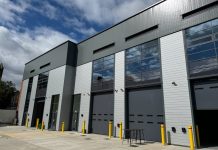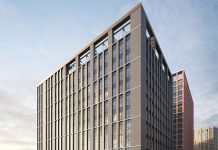Demand for prime UK industrial space has soared with take-up of grade A buildings hitting record levels over the last six months, according to the latest figures from DTZ. Supply of high-quality space is not keeping up with demand, pushing up rents and prompting developers to build speculatively in several regions.
In the first half of 2014, take-up of industrial space, including buildings for engineering, food and non-food manufacturing, logistics warehouses and retail distribution centres, reached a total of 15.9m sq ft. Just over half of this – 8m sq ft – was grade A buildings, the highest six month prime take-up figure on record.
Of the grade A take-up, 65% was through build-to-suit deals, as the lack of good quality space is causing occupiers to consider this option over existing stock. Already this year there has been 5.2m sq ft taken as build-to-suit projects, compared to 4.4m sq ft taken across the whole of 2013.
The retail sector has been resurgent in 2014 H1, contributing around half of the total UK take-up of industrial property. This is the highest proportion the sector has taken since 2010 after four years of reduced take up. In contrast, the logistics sector’s contribution dropped to 20.1% of take-up in H1 2014. Requirements in this sector, led by logistics and parcel companies expanding due to the huge growth of online retail, have in part been satisfied for now although it is expected to resume growth in due course.
Take-up in the North West has been more subdued in the first half of 2014 with 1.9m sq ft taken, down 55% from H1 2013.
Tony O’Keefe, Director, Industrial agency at DTZ in Manchester commented: “Whilst H1 figures are down on the last review period the North West continues to be at the forefront of a resurgent industrial market which will be demonstrated in the coming quarter with expected notable deals to the Hut Group(685,000 sq ft)and DHL (400,000 sq ft).
“New activity at Logistics North, Bolton following a transaction to Aldi has seen Harworth Estates begin construction of new estate roads and services to exploit its scale and 3.5 million sq ft development potential, enabling the site to emerge as the pre-eminent site in the region.
“The North West is well placed to capitalise on its strengths as an industrial powerhouse and with a series of large scale occupier requirements in the pipeline developer confidence has returned. Indeed the return of speculative development is not too far off the horizon with a series of developers considering schemes.”
Another record set in Q2 2014 was rolling four-quarter investment volumes reaching £5.8bn over the past 12 months. Each of the past three quarters has produced record volumes using this aggregate measure.
Michael Green, Research Analyst at DTZ, said: “Industrial property is becoming increasingly attractive to investors as the economy continues to grow. Indeed, the 12 month total up to Q2 2014 saw an extra £2.5bn invested compared to the previous 12 months’ total.
“This influx of capital meant almost all regions exceeded their regional half-yearly average with Wales the exception and only by £7.8m. East Midlands was the standout performer in Q2 with three separate deals of over £50m helping it achieve its strongest quarter on record. Total investment in East Midlands hit £438m in the first six months of 2014, ranking it second behind the combined total for London and South East. With money pouring into the regions, the yield gap compared to London is closing and will do for the rest of the year.”
On speculative investment, Simon Lloyd, Head of Industrial and Logistics at DTZ, said: “Grade A availability is lower than the long term average across all regions. As a consequence, rental growth is expected throughout the UK, and regions with the largest deficit of good quality space will evidence rental growth first.
“Occupier confidence is increasingly in line with the UK’s economic recovery. Companies are looking to expand into newer, larger premises resulting in the primary market activity reaching these record levels.
“Speculative development has returned as a direct consequence and is particularly evident in London, South East and the Midlands. Other regions are beginning to follow suit and most will host even more speculative development in the coming months to boost the availability of prime space and catch up with demand.”






















